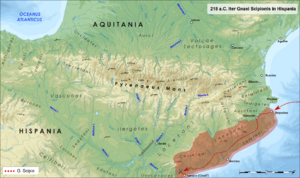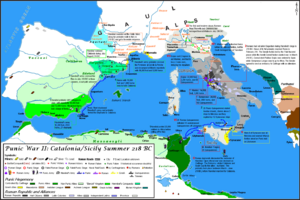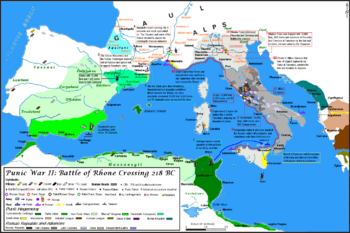Battle of Cissa facts for kids
Quick facts for kids Battle of Cissa |
|||||||
|---|---|---|---|---|---|---|---|
| Part of the Second Punic War | |||||||
 Scipio's landing in Iberia |
|||||||
|
|||||||
| Belligerents | |||||||
| Commanders and leaders | |||||||
| Gnaeus Cornelius Scipio Calvus | Hanno (POW) | ||||||
| Strength | |||||||
|
20,000 – 25,000
|
11,000
|
||||||
| Casualties and losses | |||||||
| Unknown |
8,000 6,000 killed 2,000 captured |
||||||
The Battle of Cissa was an important fight during the Second Punic War. It happened in the fall of 218 BC. The battle took place near a Celtic town called Tarraco in what is now northeastern Spain. A Roman army, led by Gnaeus Cornelius Scipio Calvus, defeated a smaller Carthaginian army. The Carthaginian army was led by Hanno.
This Roman victory gave them control of the land north of the Ebro River. Hannibal had only taken control of this area a few months earlier. This battle was the first time the Romans fought in Spain. It helped them set up a safe base among friendly local tribes. Because the Scipio brothers were so successful in Spain, Hannibal never got the extra soldiers he hoped for from Spain during the war.
Contents
Why was this battle important?
Hannibal's plan to invade Italy by land was very risky. If it failed, Carthage could lose the war quickly. But he had to choose this plan because of Carthage's situation in 218 BC. An invasion by sea would have been faster. However, a storm could sink the whole fleet. Also, the Romans had a strong navy. This made sea travel very dangerous for Hannibal's large army.
Carthage had no safe ports between the Balearic Islands and Italy. Rome controlled many islands in the area. This made a sea invasion much riskier than a land one. A land invasion also had the advantage of surprising the Romans.
Hannibal needed to move carefully to keep his plans secret. If Rome knew his intentions, they could fight on many fronts. They could block him at the Pyrenees mountains. They could also invade Africa. Hannibal waited after his victory at Siege of Saguntum. He spent months making Spain and Africa stronger. This made Rome think Carthage would fight a defensive war. This helped Hannibal's land invasion surprise Rome.
Carthaginian Army Plans
Hannibal left his younger brother, Hasdrubal Barca, in charge of Carthaginian lands south of the Ebro River. Hasdrubal had about 12,650 foot soldiers, 2,550 horsemen, and 21 elephants. Hannibal also sent 20,000 Iberian soldiers to Africa. These actions helped secure Carthage's lands.
Hannibal left Cartagena in late May or early June. He waited for the spring floods to end. This made sure there was enough food for his army. He also met with Gallic tribes from Italy. They promised to help him against the Romans. Hannibal's army was very large. It had tens of thousands of soldiers and many elephants. The Carthaginian navy stayed in Spanish waters.
Hannibal's army marched in smaller groups. They covered about 290 miles to reach the Ebro River by mid-July. This march was peaceful.
Roman Plans and Delays
Rome expected Carthage to fight a defensive war. They planned to attack both Spain and Africa. They did not expect Hannibal to invade Italy by land. The Roman plan was for Scipio to go first. He would fight Hannibal in Spain or Gaul. Then, another Roman general, Sempronius, would invade Africa from Sicily.
The Roman navy was ready in 219 BC. They had 220 warships. Consul Tiberius Sempronius Longus got 4 legions. He was to sail to Africa with 160 warships. Publius Cornelius Scipio also got 4 legions. He was to sail to Spain with 60 ships.
Why was Scipio delayed?
The Roman generals started their duties in March. But before Scipio's army was ready, two Gallic tribes attacked Roman colonies in northern Italy. These tribes were the Boii and the Insubres. This happened in April or May of 218 BC. The Roman Senate decided to protect Italy first.
They sent some of Scipio's army to help. This delayed Scipio's departure for Spain by two or three months. Hannibal's quiet actions during March to May made Rome think he would not invade Italy. When Rome heard Hannibal had crossed the Ebro, they still thought he was just securing Spain. So, Sempronius went to Sicily, and Scipio continued preparing to stop Hannibal in Gaul.
Hannibal's Campaign in Spain
While Scipio was raising new troops, Hannibal's army crossed the Ebro River. They crossed in three groups. One group went along the coast. This group, led by Hannibal, carried the treasure and elephants. They marched through towns like Tarraco and Barcelona. The different groups marched to support each other. The coastal group was ready to stop any Roman attack.
Hannibal spent July and August of 218 BC conquering the area between the Ebro River and the Pyrenees mountains. He fought against several local tribes. This campaign was tough and caused many Carthaginian losses. After taking control of these tribes, Hannibal reorganized his army.
He left a general named Hanno in charge of the new lands north of the Ebro. Hanno had 10,000 foot soldiers and 1,000 horsemen. He was based near a town called Cissa. Hanno also guarded the supplies Hannibal had left behind. Hannibal then sent home 10,000 soldiers who were not loyal. His army now had about 50,000 foot soldiers and 9,000 horsemen. They also had 37 elephants.
The Carthaginian army then crossed the Pyrenees Mountains into Gaul. They reached Illiberis in early September. This campaign gave Hannibal's new soldiers battle experience. It also showed the Iberian tribes Carthage's power. By sending away unwilling troops and heavy baggage, Hannibal made his army faster and more loyal. He probably decided to focus on reaching Italy quickly.
Hannibal avoids Scipio
Hannibal took three months to march from Cartagena to the Pyrenees. But he reached the Rhône River in just three weeks. He made deals with Gallic leaders. He gave them gifts and promised peace. So, his army marched through Gaul without trouble. They reached the Rhône River by late September.
Hannibal had to fight some Gallic tribes at the Rhône. This delayed him for a few days. This delay allowed Scipio to find him. Scipio had landed his army at Massilia in mid-September. Scipio thought Hannibal was still far away. He was surprised to learn Hannibal was already near the Rhône.
Scipio sent 300 horsemen to scout. They clashed with Carthaginian horsemen. The Romans won and found Hannibal's camp. Hannibal decided not to fight the Romans. Even a victory would cause losses. This would slow him down and force him to stay in Gaul for winter. This would ruin his plan to reach Italy.
Scipio marched north to fight Hannibal. But Hannibal marched east towards the Alps. When Scipio reached Hannibal's empty camp, he learned Hannibal was three days ahead. Scipio decided not to follow Hannibal into the Alps. His army was not ready for a winter campaign. Also, marching into unknown lands was risky.
Hannibal had moved faster than Rome expected. He had avoided Scipio in Gaul. This meant Scipio failed to stop Hannibal from reaching Italy. Scipio returned to the coast. He sent most of his army to Spain under his older brother, Gnaeus. Publius Scipio himself returned to Italy with a small group. He wanted to organize defenses against Hannibal there.
This plan had two goals. Gnaeus Scipio would stop Hannibal from getting help from Spain. Publius Scipio hoped to defeat Hannibal in Italy. This would bring glory to the Scipio family. Gnaeus Scipio likely reached Spain by ship in mid-October.
Before the Battle
The Romans arrived in Spain about a month after Hannibal left. They surprised Hanno, the Carthaginian commander in Catalonia. Hanno had 10,000 foot soldiers and 1,000 horsemen. He was supposed to watch over a pro-Roman tribe. But he had to march 150 miles south to stop a rebellion. So, the Carthaginians were not ready for the Roman arrival.
Hanno probably did not have enough soldiers to stop the Romans. He pulled back inland to Cissa. This town might have been near Lérida. He started gathering more local soldiers. Hasdrubal Barca, who was far away in Cartagena, was also surprised. He marched north with 8,000 foot soldiers and 1,000 horsemen to join Hanno.
Gnaeus Cornelius Scipio Calvus arrived at Emporiae in Spain with 60 warships. The Greek cities there welcomed the Romans. Gnaeus began moving south along the coast. He used diplomacy and force to win over coastal tribes. He gained control of the coast up to Tarraco, which surrendered to the Romans.
The Carthaginians stayed on the defensive. They waited for Hasdrubal to arrive and gather more troops. Gnaeus Scipio then marched inland towards Cissa. Hanno was based there. Hanno saw that the Carthaginians were losing control of the newly conquered tribes. So, he decided to fight the Romans instead of waiting for Hasdrubal.
The Battle of Cissa
Scipio's army had about 20,000 to 25,000 soldiers. This included Roman and allied troops, plus some local Spanish helpers. Hanno had about 11,000 soldiers. He had also gathered some local allies. But his army was still much smaller than the Roman one.
The battle was a direct fight. There were no clever tricks or ambushes. The armies lined up and faced each other. Hanno's army was outnumbered two to one. They were defeated quite easily. About 6,000 Carthaginian soldiers were killed in the battle.
The Romans also captured the Carthaginian camp. They took 2,000 more soldiers, including Hanno himself. The camp held all the supplies Hannibal had left behind. Among the prisoners was Indibilis, a local chieftain who would cause trouble for the Romans later. The Romans also attacked the town of Cissa. But they were disappointed because it did not have much valuable treasure.
What happened next?
Gnaeus Scipio now controlled the land north of the Ebro. Hasdrubal arrived too late to help Hanno. He was not strong enough to attack the Romans directly. But he did send a small group of horsemen and foot soldiers on a raid. This group surprised some Roman sailors and marines who were looking for food. They caused many losses. This reduced the Roman fleet's strength in Spain.
The Roman fleet then raided Carthaginian lands in Spain. Some local tribes, like the Ilergetes, started attacking pro-Roman tribes. Hasdrubal might have crossed the Ebro again to support them. Scipio had to send groups to punish these tribes and restore peace. Rome's power grew in Spain. Carthage had suffered a big loss.
After punishing the naval officers for their lack of discipline, Scipio gave the captured goods to his soldiers. Scipio and the Roman army spent the winter at Tarraco. Hasdrubal went back to Cartagena. He left soldiers in allied towns south of the Ebro.
If Hanno had won this battle, Hannibal might have gotten more soldiers from Spain as early as 217 BC. This battle helped Scipio in Spain, much like the Battle of Trebia helped Hannibal in Italy. It gave Scipio a base and new allies for supplies and soldiers. Most importantly, it cut off Hannibal's land route for help from Spain.
Unlike Hannibal, Scipio did not immediately attack enemy land south of the river. He took time to make his control stronger. He made friends with or conquered local tribes. He also raided Carthaginian lands. These actions prepared the way for future Roman operations in Spain.
Why was this battle so important for the war?
Hannibal had marched slowly through Spain. This was probably to give Rome time to invade Spain and be defeated. He also wanted to make his march seem difficult before he went to Italy. The Gallic rebellion delayed Scipio's arrival in Spain. This delay probably saved Scipio's army from being destroyed. Hannibal had a much larger army than Scipio.
Hannibal's fast march through Gaul ruined Rome's plan. Hannibal had already crossed the Ebro before Scipio even sailed. By the time the Romans reached the Rhône, Hannibal had already crossed that river too. Scipio only found this out by chance. Scipio could no longer stop Hannibal from reaching Italy. But he could still go to Spain, which was Rome's second goal.
Scipio's decision to send his brother to attack Spain was very important. Because the Scipio brothers were successful in Spain, Hannibal never received reinforcements from Spain during the war. One historian even suggested that if Publius Scipio had not sent his army to Spain in 218 BC, his son might not have won the Battle of Zama in 202 BC.
However, Publius Scipio also missed a chance. He could have brought his army back to Italy. Then, Rome would have had a much larger army to fight Hannibal in Italy. This might have allowed Rome to attack Hannibal as he came out of the Alps, tired and weakened. Some historians believe Scipio made a big mistake by sending his army to Spain. This might have made the war last much longer.
See also
 In Spanish: Batalla de Cissa para niños
In Spanish: Batalla de Cissa para niños



